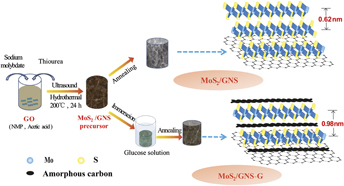Crossref Citations
This article has been cited by the following publications. This list is generated based on data provided by
Crossref.
Chao, Yunfeng
Ge, Yu
Zhao, Yong
Jiang, Jicheng
Wang, Caiyun
Qin, Chunyan
Vijayakumar, Amruthalakshmi
Yu, Changchun
and
Wallace, Gordon G.
2018.
Tuning the structure of three dimensional nanostructured molybdenum disulfide/nitrogen-doped carbon composite for high lithium storage.
Electrochimica Acta,
Vol. 291,
Issue. ,
p.
197.
Zhu, Xingqun
Li, Jing
Ali, Rai Nauman
Huang, Meng
Liu, Ping
and
Xiang, Bin
2018.
Toward a high-performance Li-ion battery: Constructing a Co1−xS/ZnS@C composite derived from metal-organic framework @3D disordered polystyrene sphere template.
Materials & Design,
Vol. 160,
Issue. ,
p.
636.
Xie, Kai
Liu, Zhenghao
Wang, Yourong
Song, Guangsen
and
Cheng, Siqing
2018.
A facile synthesis of hierarchical MoS2 nanotori with advanced lithium storage properties.
New Journal of Chemistry,
Vol. 42,
Issue. 13,
p.
10935.
Zhang, Liugen
Li, Hui
Xie, Hongtao
Chen, Tingxiang
Yang, Chao
and
Wang, Jide
2018.
MOF-driven ultra-small hollow Co9S8 nanoparticles embedded in porous carbon for lithium-ion batteries.
Journal of Materials Research,
Vol. 33,
Issue. 10,
p.
1496.
Wu, Cheng-Yu
Chang, Wei-En
Sun, Yu-Guang
Wu, Jyh-Ming
and
Duh, Jenq-Gong
2018.
Three-dimensional S-MoS2@α-Fe2O3 nanoparticles composites as lithium-ion battery anodes for enhanced electrochemical performance.
Materials Chemistry and Physics,
Vol. 219,
Issue. ,
p.
311.
Kanaujiya, Neha
Kumar, Nagesh
Sharma, Yogesh
and
Varma, G. D.
2019.
Probing the Electrochemical Properties of Flower Like Mesoporous MoS2 in Different Aqueous Electrolytes.
Journal of Electronic Materials,
Vol. 48,
Issue. 2,
p.
904.
Cao, Xiaoyu
Liu, Jingbo
Zhu, Limin
and
Xie, Lingling
2019.
Polymer Electrode Materials for High‐Performance Lithium/Sodium‐Ion Batteries: A Review.
Energy Technology,
Vol. 7,
Issue. 7,
Li, Sha
Lee, Ja Kyung
Zhou, Si
Pasta, Mauro
and
Warner, Jamie H.
2019.
Synthesis of Surface Grown Pt Nanoparticles on Edge-Enriched MoS2 Porous Thin Films for Enhancing Electrochemical Performance.
Chemistry of Materials,
Vol. 31,
Issue. 2,
p.
387.
Nazari, Hojjatollah
Heirani‐Tabasi, Asieh
Alavijeh, Mohammadhossein Shahsavari
Jeshvaghani, Zahra Shojaei
Esmaeili, Elaheh
Hosseinzadeh, Simzar
Mohabatpour, Fatemeh
Taheri, Behnaz
Tafti, Seyed Hossein Ahmadi
and
Soleimani, Masoud
2019.
Nanofibrous Composites Reinforced by MoS2 Nanosheets as a Conductive Scaffold for Cardiac Tissue Engineering.
ChemistrySelect,
Vol. 4,
Issue. 39,
p.
11557.
Yousaf, Muhammad
Wang, Yunsong
Chen, Yijun
Wang, Zhipeng
Firdous, Attia
Ali, Zeeshan
Mahmood, Nasir
Zou, Ruqiang
Guo, Shaojun
and
Han, Ray P. S.
2019.
A 3D Trilayered CNT/MoSe2/C Heterostructure with an Expanded MoSe2 Interlayer Spacing for an Efficient Sodium Storage.
Advanced Energy Materials,
Vol. 9,
Issue. 30,
Zeng, Feng
Xi, Xiaoying
Cao, Huatang
Pei, Yutao
Heeres, Hero Jan
and
Palkovits, Regina
2019.
Synthesis of mixed alcohols with enhanced C3+ alcohol production by CO hydrogenation over potassium promoted molybdenum sulfide.
Applied Catalysis B: Environmental,
Vol. 246,
Issue. ,
p.
232.
Nazari, Hojjatollah
Heirani‐Tabasi, Asieh
Hajiabbas, Maryam
Khalili, Masoud
Shahsavari Alavijeh, Mohammadhossein
Hatamie, Shadie
Mahdavi Gorabi, Armita
Esmaeili, Elaheh
and
Ahmadi Tafti, Seyed Hossein
2020.
Incorporation of two‐dimensional nanomaterials into silk fibroin nanofibers for cardiac tissue engineering.
Polymers for Advanced Technologies,
Vol. 31,
Issue. 2,
p.
248.
Mateti, Srikanth
Rahman, Md Mokhlesur
Cizek, Pavel
and
Chen, Ying
2020.
In situ production of a two-dimensional molybdenum disulfide/graphene hybrid nanosheet anode for lithium-ion batteries.
RSC Advances,
Vol. 10,
Issue. 22,
p.
12754.
Choi, Jin-Hyeok
Kim, Min-Cheol
Moon, Sang-Hyun
Kim, Hyeona
Kim, Yo-Seob
and
Park, Kyung-Won
2020.
Enhanced electrochemical performance of MoS2/graphene nanosheet nanocomposites.
RSC Advances,
Vol. 10,
Issue. 32,
p.
19077.
Zhang, KaiBo
Jiang, XiaoBing
Zeng, Min
and
Jing, Bo
2020.
Hydrothermal synthesis of three-dimensional hydrangea-like MoSe2@N-doped carbon anode material for high performance lithium ion batteries.
Journal of Electroanalytical Chemistry,
Vol. 879,
Issue. ,
p.
114818.
Chen, Biao
Chao, Dongliang
Liu, Enzuo
Jaroniec, Mietek
Zhao, Naiqin
and
Qiao, Shi-Zhang
2020.
Transition metal dichalcogenides for alkali metal ion batteries: engineering strategies at the atomic level.
Energy & Environmental Science,
Vol. 13,
Issue. 4,
p.
1096.
Torul, Hilal
Yarali, Ece
Eksin, Ece
Ganguly, Abhijit
Benson, John
Tamer, Ugur
Papakonstantinou, Pagona
and
Erdem, Arzum
2021.
Paper-Based Electrochemical Biosensors for Voltammetric Detection of miRNA Biomarkers Using Reduced Graphene Oxide or MoS2 Nanosheets Decorated with Gold Nanoparticle Electrodes.
Biosensors,
Vol. 11,
Issue. 7,
p.
236.
Yuan, Ding
Dou, Yuhai
Wu, Zhenzhen
Tian, Yuhui
Ye, Kai-Hang
Lin, Zhan
Dou, Shi Xue
and
Zhang, Shanqing
2022.
Atomically Thin Materials for Next-Generation Rechargeable Batteries.
Chemical Reviews,
Vol. 122,
Issue. 1,
p.
957.
Khan, Mayur
Tripathi, Madhvendra Nath
and
Tripathi, Ambuj
2022.
Strain-induced structural, elastic, and electronic properties of 1L-MoS2.
Journal of Materials Research,
Vol. 37,
Issue. 20,
p.
3340.
Wang, Xiaxia
Yang, Kai
Na, Ren
Liu, Xu
Shan, Zhongqiang
and
Wang, Shirong
2022.
Preparation and Lithium Storage Properties of Hierarchical Hydrangea‐Like MoS2/C Composites.
Energy Technology,
Vol. 10,
Issue. 6,






